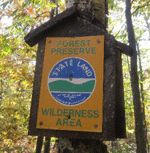Almost 5,000 pages of written public comments, most supporting Wilderness classification, were submitted as part of the recent public hearing concerning some 46,000 acres of newly purchased and existing Forest Preserve lands around the Essex Chain Lakes area and 22 miles of the Hudson River. The carefully argued and highly emotional comments, were acquired from the Adirondack Park Agency (APA) through a Freedom of Information Act (FOIA) request. The comments were emailed, faxed and mailed; some were handwritten or sent from iPads and smartphones. They included a variety of form letters and petitions.
 The nearly 5,000 pages were part of some 3,600 written comments submitted in total. Only the written comments were included in the FOIA request. An analysis of testimony from the eight public hearings; five held in the Adirondacks, three outside the Park, was not included. Around 200 total speakers made statements at those hearings, many speaking more than once.
The nearly 5,000 pages were part of some 3,600 written comments submitted in total. Only the written comments were included in the FOIA request. An analysis of testimony from the eight public hearings; five held in the Adirondacks, three outside the Park, was not included. Around 200 total speakers made statements at those hearings, many speaking more than once.
The written comments tracked the public hearings with a sharp Wilderness and Wild Forest divide. The difference was that at the public hearings more people spoke for Wild Forest while the written comments had more Wilderness supporters. A rough count had about 2,700 backing Wilderness classification, and around 800 backing Wild Forest. There were over 100 letters where it was difficult to determine what the author was advocating; for example a number endorsed “Forest Preserve classification.” There were a handful of Canoe and Primitive classification support comments submitted.
Many who spoke at public hearings also submitted written comments. A number of written comments seemed to have been submitted multiple times.
There were a variety of petitions submitted as well. The Upper Hudson River Recreation Hub submitted petitions with 200 or so names in support of Wild Forest. PROTECT-ADK-Sierra Club jointly submitted a petition with over 2,100 names supporting a Wilderness classification. The Childwold Snowpackers submitted 46 form letters backing Wild Forest.
There were many form letters submitted on both sides. In fact, the majority of written comments in each camp were form letters of one sort or another.
Groups submitting letters or resolutions backing a Wild Forest classification included the Hamilton County Board of Supervisors, Local Government Review Board, Town of Long Lake, Town of Indian Lake, Town of North Hudson, Town of Minerva (Minerva Supervisor Sue Montgomery Corey submitted the most, and longest, comments), New York State Fish & Wildlife Management Board, NYS Snowmobile Association, NYS Conservation Council, Adirondack Association of Towns and Villages, Town of Inlet, Lewis County Board of Supervisors, Fulton County Board of Supervisors, Trout Unlimited, CAP-21, and various county sportsmen groups, mountain biking groups, hunting and fishing clubs, among others. The town attorney for the Town of Indian Lake sent a detailed and argumentative letter that appears to be laying the legal groundwork for a court challenge.
The Wilderness camp was headed up by the Adirondack Mountain Club, a number of ADK chapters, Protect the Adirondacks, Adirondack Wild, Adirondack Council, Audubon New York, Environmental Advocates, Environment New York, the Sierra Club, various chapters of the Sierra Club, the Wildlife Conservation Society, and the Holy Myrrhbearers Monestary, among others.
Adirondack Architectural Heritage called for saving the farm house at the Outer Gooley Club, as did many other writers.
Former APA Commissioner Peter Paine, and lead author of the State Land Master Plan, called for a Canoe classification, with a fallback for Primitive. Former APA Commissioners Liz Thorndike and John Collins called for Wilderness. Former APA Executive Director Bob Glennon called for Wilderness. Former APA Commissioners Rick Hoffman and former DEC Deputy Commissioner Chris Amato backed a Canoe classification.
Over 30 form letters were submitted in support of a Wilderness classification and naming it after Adirondack conservation icon Paul Schaefer.
APA organized the comments by date received. Wild Forest and snowmobiling supporters got off to a strong start with the majority of letters in the first weeks of the hearing cycle, but the Wilderness groups finished stronger with some big form letter campaigns.
The contents of the hearing, both written and oral comments, are great fodder and data for evaluating public attitudes towards Wilderness and machines in the forest in the first decades of the 21st Century. Great sociological, public process and political science studies could be performed from these comments.
Updates and summaries of the comments are expected to be presented at the August and/or September APA meetings as the agency makes its decision.
While this is a strong showing the DEC is still pushing a Wild Forest designation. Awhile back, the PROTECT Executive Director wrote a piece on the Adirondack Almanack stating that the DEC’s political might over the APA and the APA’s lack of independence made a Wild Forest designation a done deal.
Hats off to all who put in public comments! All sides will continue to push for the classification of their choice.





